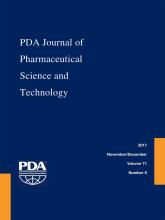Research ArticleTechnology/Application
Enhancing Patient Safety through the Use of a Pharmaceutical Glass Designed To Prevent Cracked Containers
Robert A. Schaut, Kyle C. Hoff, Steven E. Demartino, William K. Denson and Ronald L. Verkleeren
PDA Journal of Pharmaceutical Science and Technology November 2017, 71 (6) 511-528; DOI: https://doi.org/10.5731/pdajpst.2017.007807
Robert A. Schaut
Corning Incorporated, Corning, NY 14831
Kyle C. Hoff
Corning Incorporated, Corning, NY 14831
Steven E. Demartino
Corning Incorporated, Corning, NY 14831
William K. Denson
Corning Incorporated, Corning, NY 14831
Ronald L. Verkleeren
Corning Incorporated, Corning, NY 14831

References
- 1.↵U.S. National Archives and Records Administration. Title 21. Drug Product Containers and Closures. Section 211.94 In Code of Federal Regulations; 2016.
- 2.↵U.S. Department of Health and Human Services, Food and Drug Administration, Center for Drug Evaluation and Research, Center for Biologics Evaluation and Research. Container Closure Systems for Packaging Human Drugs and Biologics; 1999.
- 3.↵
- Maki D. G.,
- Goldmnan D. A.,
- Rhame F. S.
- 4.↵
- 5.↵
- 6.↵
- Schaut R. A.,
- Weeks W. P.
- 7.↵
- Felton L.
- Akers M. J.
- 8.↵
- Eakins M. N.
- 9.↵
- Kuehn S. E.
- 10.↵PDA Technical Report 43. Identification and Classification of Nonconformities in Molded and Tubular Glass Containers for Pharmaceutical Manufacturing: Covering Ampoules, Bottles, Cartridges, Syringes and Vials. Parenteral Drug Association: Bethesda, MD, 2013.
- 11.↵
- Sack R. A.
- 12.↵
- 13.↵
- Maddocks A. C.,
- Raine G.
- 14.↵
- Elin R. J.,
- Lundberg W. B.,
- Schmidt P. J.
- 15.↵
- Daisy J. A.,
- Abrutyn E. A.,
- Mac G. R.
- 16.↵
- Frechette V. D.
- 17.↵
- Bloomfield S.,
- Exner M.,
- Flemming H.-C.,
- Goroncy-Bermes P.,
- Hartemann P.,
- Heeg P.,
- Ilschner C.,
- Krämer I.,
- Merkens W.,
- Oltmanns P.,
- Rotter M.,
- Rutala W. A.,
- Sonntag H.-G.,
- Trautmann M.
- 18.↵
- Nema S.,
- Ludwig J. D.
- Swift R.
- 19.↵USP Committee of Revision. <1207> Package Integrity Evaluation—Sterile Products. In The United States Pharmacopeia, Thirty-ninth Revision; US Pharmacopeia, 2016.
- 20.↵
- Maki D. G.,
- Martin W. T.
- 21.↵
- Phillips I.,
- Meers P.D.,
- D'Arcy P.F.
- 22.↵Pharmaceutical Technology Editors. Injectables to Show Double-Digit Growth Through 2020 PharmTech.com [Online], 2015. http://www.pharmtech.com/injectables-show-double-digit-growth-through-2020.
- 23.↵USP Committee of Revision. <1207.2> Package Integrity Leak Test Technologies. In The United States Pharmacopeia, Thirty-ninth Revision; US Pharmacopeia, 2016.
- 24.↵
- Uhlmann D.
- Gardon R.
- 25.↵
- Bradt R. C.,
- Munz D.,
- Sakai M.,
- White K. W.
- Tandon R.,
- Glass S. J.
- 26.
- Lawn B.,
- Marshall D.
- 27.↵
- Gy R.
- 28.↵
- Schaut R. A.,
- Peanasky J. S.,
- DeMartino S. E.,
- Schiefelbein S. L.
- 29.↵
- Timmons C.,
- Liu C. Y.,
- Merkle S.
- 30.↵
- Clark C. C.,
- Yudenfriend H.,
- Redner A. S.
In This Issue
PDA Journal of Pharmaceutical Science and Technology
Vol. 71, Issue 6
November/December 2017
Enhancing Patient Safety through the Use of a Pharmaceutical Glass Designed To Prevent Cracked Containers
Robert A. Schaut, Kyle C. Hoff, Steven E. Demartino, William K. Denson, Ronald L. Verkleeren
PDA Journal of Pharmaceutical Science and Technology Nov 2017, 71 (6) 511-528; DOI: 10.5731/pdajpst.2017.007807
Enhancing Patient Safety through the Use of a Pharmaceutical Glass Designed To Prevent Cracked Containers
Robert A. Schaut, Kyle C. Hoff, Steven E. Demartino, William K. Denson, Ronald L. Verkleeren
PDA Journal of Pharmaceutical Science and Technology Nov 2017, 71 (6) 511-528; DOI: 10.5731/pdajpst.2017.007807
Jump to section
- Article
- Abstract
- Introduction
- Understanding Crack Formation in Conventional Glass Containers
- Three Methods for Replicating Stable Cracks in Parenteral Containers
- Dye Ingress Leak Testing
- Preventing Formation of Stable Cracks
- Demonstrating Prevention of Stable Cracks
- Engineered Safety Benefits of Glass in Other Industries
- Conclusions
- Conflict of Interest Statement
- Acknowledgments
- References
- Figures & Data
- References
- Info & Metrics
Related Articles
- No related articles found.





